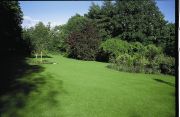Saving the planet one blade of grass at a time
With everything from gardens and fields to roadside verges and riverbanks covered in grass, it's easy to take the green stuff for granted, even when it's dry and crispy in the current heatwave. The truth is, though, that grasses fulfil a complex role in our ecosystem, especially in urban areas where any kind of plant life is thin on the ground. The experts at Johnsons Lawn Seed take a look at the environmental benefits of grass, from carbon sequestration to air purification and water management.
Did you know…?
A single hectare of grass can produce enough oxygen for 150 people to breathe, whilst also filtering dust and other particles from the air. Closer to the ground it guards against soil erosion and helps prevent flash flooding and excess water runoff by filtering water slowly into the ground. This is in stark contrast with the water damage that can be caused in areas where gardens have been concreted over, covered in fake plastic grass and the natural environment is constantly under pressure from manmade structures.
Like all plants, grass can also help to regulate temperatures - something we could do with a bit more of right now - and the creation of parks and community gardens in urban areas can help to keep towns and cities cool as temperatures rise.
Carbon capture
Perhaps most intriguingly, however, grass is an efficient means of transferring carbon to the soil. Simply put, grass leaves capture CO2 and grass roots sequestrate CO2 into the soil as carbon. 100m2 of grass sequestrates 336kgs of carbon into the soil each year - the equivalent of 1.23 tons of CO2 annually and more carbon per square metre than trees.
Grass – especially managed turf - outperforms forests and soil when it comes to capturing CO2. Whilst the carbon in trees is mainly locked into the trunks as lignin (woody matter) with a ratio of 80:20 above ground to below ground biomass, grass is the other way around. Denser, deeper and faster growing grass root systems produce more organic matter and hence trap more carbon. The speed at which grass can grow and the surface area that grass covers makes it a carbon capture hero of the plant world.
The Consumer Manager at Johnsons Lawn Seed – the UK’s oldest lawn seed brand - Guy Jenkins, comments: “Fast growing, relatively easy to maintain and with excellent CO2 sequestration properties, the environmental benefits of natural grasses are huge and should be considered by urban planners and property developers who care about the planet and want to meet their sustainability commitments. We are seeing far too much concrete, plastic and other manmade materials covering outdoor spaces – not only is this contributing to the increasing flood hazard in many areas, but it is also greatly limiting our ability to control atmospheric CO2 that would otherwise be absorbed by grass.”
Johnsons Lawn Seed Product Range
Johnsons Lawn Seed offers a wide range of innovative lawn seed solutions including lawn seed to tackle dog pee burn, shady spaces, lawns in need of a quick fix and those that suffer from excess moss or those that just want to win ‘lawn of the year’, including: Tuffgrass with Dog Patch Resistance; Quick Lawn with Accelerator-treated seed; Luxury Lawn Seed; After Moss Lawn Seed; Lawn Thickener Lawn Seed with SeedBooster and Shady Place Lawn Seed.
To find out more about Johnsons Lawn Seed products please visit www.johnsonslawnseed.com/product-range

